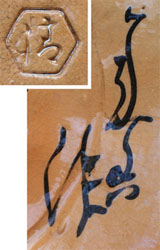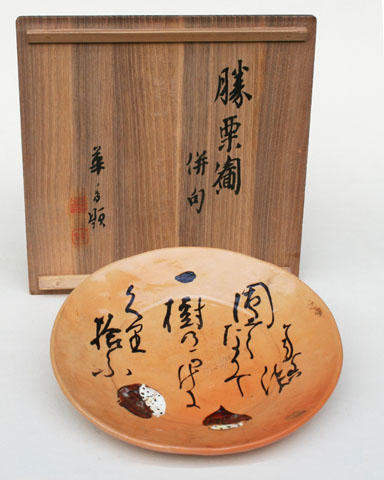nihonga
Kawarake sara, kawarake dish - Kuri,Chestnuts with haikuSigned: Kakô saku
Seals: Kiyo
Technique: Orange Kyôyaki with silver (or mica) with a multi coloured under glaze painting of chestnuts Kawarake ware unglazed of and sun-dried earthenware Ø 21.5 x 3.3
Box: signed by both potter and painter
Condition: fine
圓くなりて 一樹のかけに 久里拾ふ
Maruku narite
ichiju no kage ni
kuri hirofu
Collecting chestnuts,
in the circle of the shade
of the tree.
Kakô was one the most important painters of the modern Kyoto school. Kôno Bairei (1844-95) taught both him and Takeuchi Seihô (1864-1942), who eclipsed Kakô during his lifetime. In my opinion though, Kakô was the better artist, more innovative and daring. The tide is turning now and his art is getting the recognition it deserves.
Kakô was born in Kyoto. His father was a Yûzen textile artisan, who encouraged his son to pursue a career in painting. He became a pupil of Bairei in 1880. From 1899 on he studied Zen under the Zen master Sôen Mokurai (1854-1930) at the Kennin-ji. Zen became an important element in his work. He served as director of the Kyoto Municipal School of Fine Arts and Crafts, adjudicator for the Teiten and several Kyoto exhibition groups and up to 1920 he was a frequent exhibitor and prize-winner at the Bunten.
Reference:
Kyoto 2006
Berry & Morioka ‘99 p.40-53 (# 29-45)
Conant p. 327 (# 117-119)
Aburai p. 253-254
Roberts p.189
Rokubei V (Shôrei) (1875-1959) was the second son of Kiyomizu Rokubei IV.
Rokubei V studied Shijô painting with Kôno Bairei (1844-1895). Kikuchi Hôbun (1862-1918), Taniguchi Kôkyô (1864-1915), Takeuchi Seihô (1864-1942) and Tsuji Kakô (1870-1931) were his classmates. He also studied at the Kyoto Prefectural School of Painting, and studied ceramic techniques with his father after graduation. His career as a ceramic artist began when he won a prize at the Fourth Domestic Industrial Exposition in 1895. He studied glazing techniques at the Kyoto Municipal Ceramic Laboratory established in 1896 and organized the Promoting Society for Craft Workers (Shokkô Shôrei-kai) with designer Kikuchi Sokû at the Laboratory in 1899. He actively worked on the study and research of new glazing techniques and (Western) designs. When Rokubei IV retired, he inherited the title and became Rokubei V in 1913. He exhibited at the Nôten, the Design and Applied Artworks Exhibition sponsored by the Ministry of Agriculture and Commerce and the Teiten, the Imperial Art Academy Exhibition. He also became a member of the Imperial Art Academy and played an important role as a leading figure of the craft world. In 1945 he retired and took the artist’s name Rokuwa.
Reference:
Kyoto ‘03, ’Sekka’ p. 326 ff.
Price: ON REQUEST

